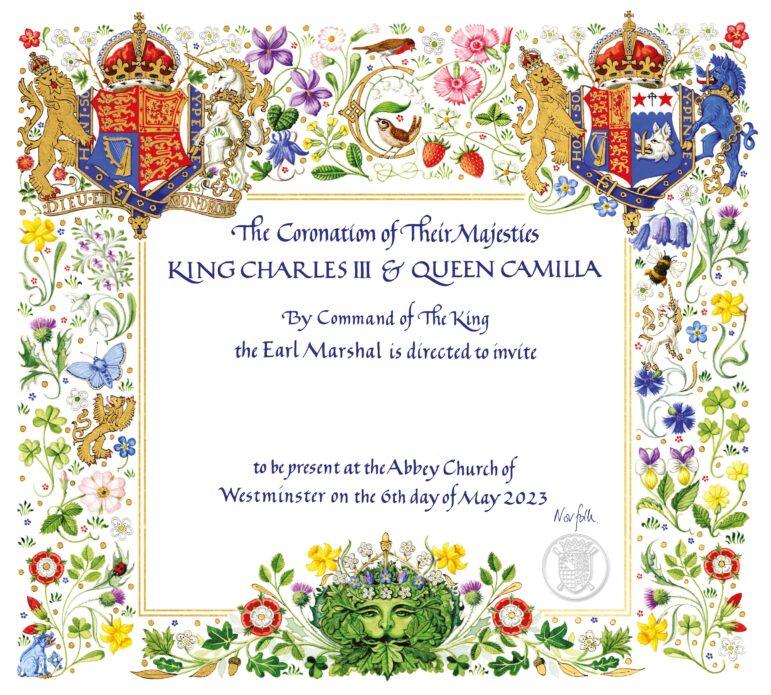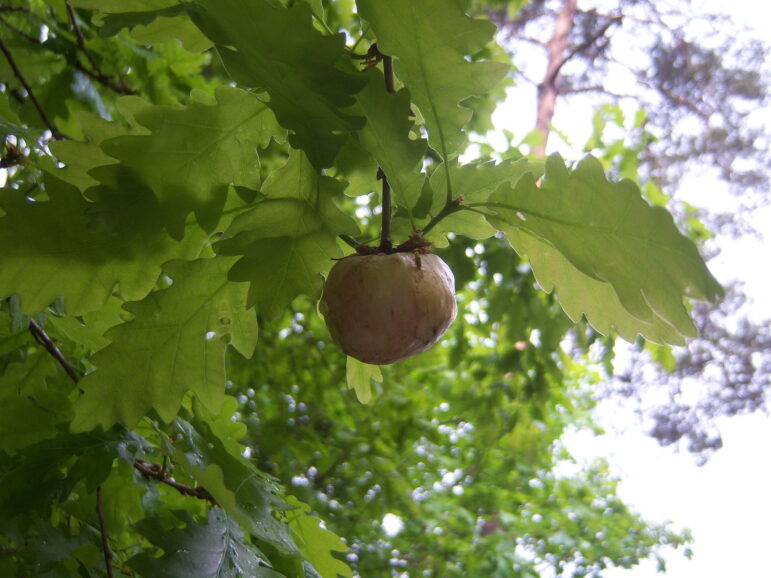LONDON – The Green Man, a familiar symbol to contemporary Pagans, popped up in the news a week or so ago in a slightly unexpected place: featuring on the formal invitation to King Charles III’s coronation on May 6, 2023. Amid a plethora of spring flowers and heraldic images, the Green Man appears at the bottom of the invitation. He is crowned with a pair of leaves that look like delicate horns and there is an acorn balanced on top of his head. We know that the Green Man appears in many forms in British folklore and in churches, but although he has been adopted by Paganism, he does not appear historically to be a particularly Pagan figure, which we’ll look at in more depth below.
The Royal Family’s own Twitter account stated that:
‘Designed by Andrew Jamieson, the invitation features the Green Man, an ancient figure from British folklore, symbolic of spring and rebirth, to celebrate the new reign.’
Jamieson is a heraldic artist and manuscript illuminator. He is a Brother of the Art Workers’ Guild (the King is an Honorary Member).

King Charles III and Queen Camilla’s Coronation Invitation- via Buckingham Palace
However, the controversy was kicked off in the national press by a complaint from that bastion of theological conservatism, namely the former banjoist and lead guitarist of the British folk rock band Mumford & Sons who tweeted:
“Why is the Jolly Green Giant more prominent on the Coronation invite than any Christian symbols?
He’s the head of the church.
Has he forgotten the first commandment? “Thou shalt have no other gods before me”
This is paganism. Shame.”
His complaint was swiftly countered by a welter of quite well-informed commentary, some of it (namely Alice Roberts, professor of Public Engagement in Science and a prominent historian on British media) citing Lady Raglan, who was the first commentator to denote the foliate heads in churches as ‘green men.’ She did so in a 1939 article “The Green Man in Church Architecture” in The Folklore Journal and was likely to have been inspired by carvings at St. Jerome’s Church in Llangwm, Monmouthshire. Lady Raglan was not a prolific commentator on matters folkloric, for it was the only article she ever wrote – but its content was certainly enduring and oddly influential.
Raglan linked the foliate heads found in churches to the green men found in May Day celebrations across both Britain and Europe and ultimately to Robin Hood, that perennially popular outlaw of Sherwood Forest and champion of the poor and oppressed. It’s not clear, however, if the foliate heads in churches are actually related to any of these other manifestations of green men, or whether they were simply a stonemason’s whimsy, or have some other explanation – such as the relationship with the Christian church and the natural world, as suggested below. We can speculate endlessly but have little or no direct evidence.
Returning to the Royal invitation, Overseas Minister Zac Goldsmith tweeted:
‘Green Man is one of the most ancient symbols of all, and appears on countless churches across the land and beyond. It is a symbol, among other things, of our relationship with the natural world (or in Christian terms, God’s creation). This is beautiful.’
The image is not an entirely surprising choice from a monarch who has had a decades-long interest in environmentalism. The symbol may also be a nod to the location of the Coronation, since there is a Green Man in Westminster Abbey, at the top of the quire screen façade.
The tiny acorn on top of the Green Man’s head might be a tribute to the Princess of Wales, whose coat of arms was designed to include acorns: she is from Berkshire and the county has a number of oak woods. Some commentators, however, have interpreted it as a symbol of Oak Apple Day, which was the May 29th holiday to commemorate the restoration of King Charles II. The story goes that the king escaped death at the hands of the Roundheads by hiding in an oak tree at Boscobel, Also known as Restoration Day, Shick Shack Day (an old name for oak galls/apples), or Oak and Nettle Day. This celebration had a transgressive element all of its own: in some areas, if you were not seen to be wearing an oak gall or a sprig of oak leaves, you were thrashed with nettles or bombarded with birds’ eggs, and in Sussex, you could be pinched, hence the local name of Pinch Bum Day.

Gall (Oak Apple) on oak by Biorhiza pallida [Photo Credit: EapClochydd CC BY-SA 3.0]
This mild violence came to an end in 1859 when the celebration was officially abolished, but some parishes still hold it today: Upton-on-Severn in Worcestershire, Membury in Devon and St Neot’s in Cornwall among them. These days it is a sedate affair, involving the church and sometimes a small town parade of worthies such as the local Mayor, but there is a Civil War re-enactment at Moseley Old Hall in the Midlands – one of the houses where Charles was said to have taken shelter during his flight from Cromwell’s men. In Fownhope, in Herefordshire, the Heart of Oak Society also keeps this old tradition going: this is another example of revival, since the Society was re-instigated in 1989, and is also an instance of an event that has seen an increase in popularity over the years.
The Royal invitation also features a robin and a wren – Pagans may be familiar with folk customs such as the hunting of the wren, which used to take place at midwinter across Welsh villages and elsewhere. It’s still carried out today, but with a mock wren rather than an actual little bird, and the wren is often treated as a symbol of rebirth. The Green Man himself is composed of oak, hawthorn, and ivy: all of which feature in Robert Graves’ compilation of the Battle of the Trees which informs so much of modern Ogham lore. The borders of the invite depict a wildflower meadow. Despite the theological disapproval of the member of Mumford and Sons, and whatever you think of the monarchy, the invitation is a beautiful piece of watercolour illustration and of interest to anyone with a fascination for heraldry and symbolism.
The Wild Hunt is not responsible for links to external content.
To join a conversation on this post:
Visit our The Wild Hunt subreddit! Point your favorite browser to https://www.reddit.com/r/The_Wild_Hunt_News/, then click “JOIN”. Make sure to click the bell, too, to be notified of new articles posted to our subreddit.
